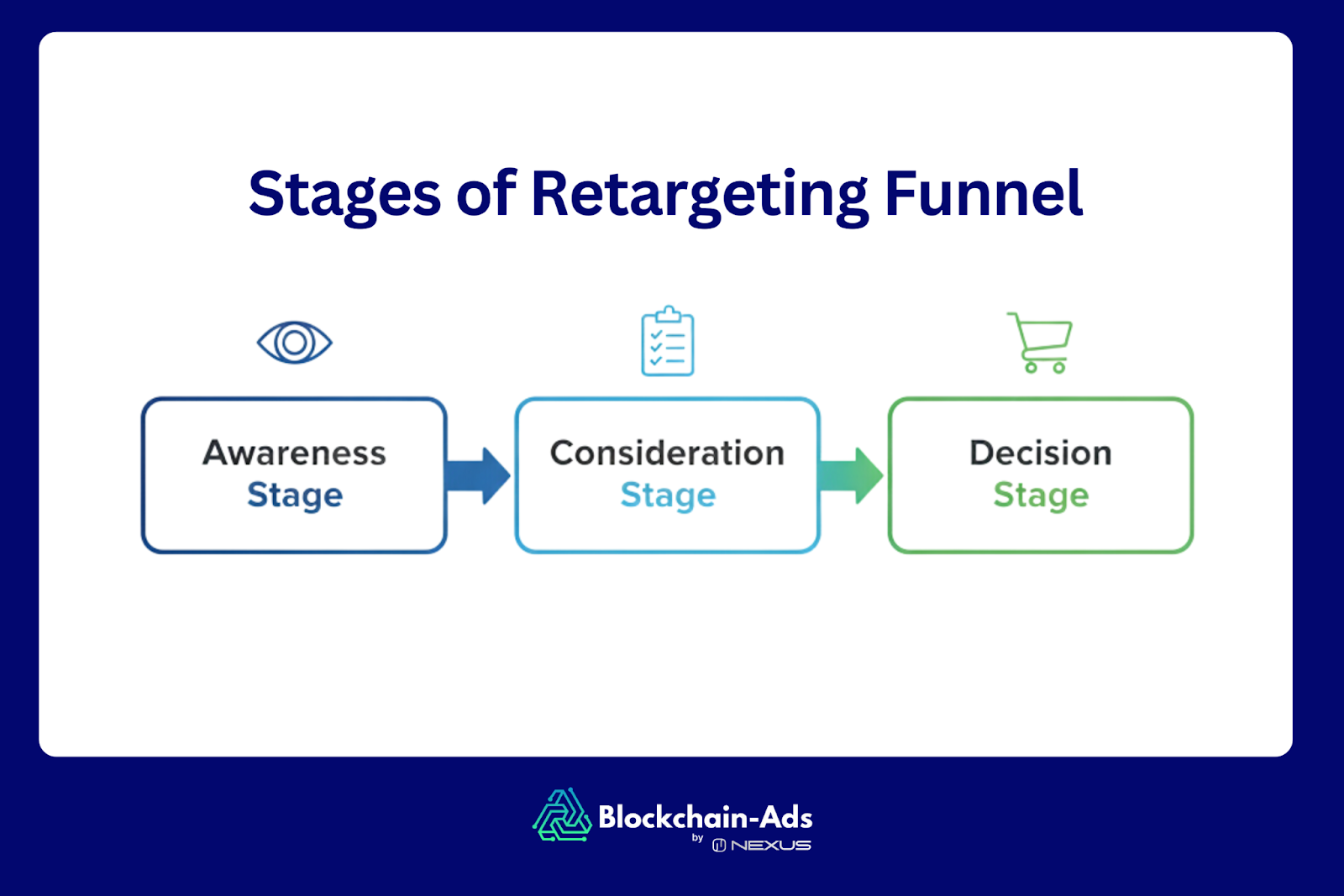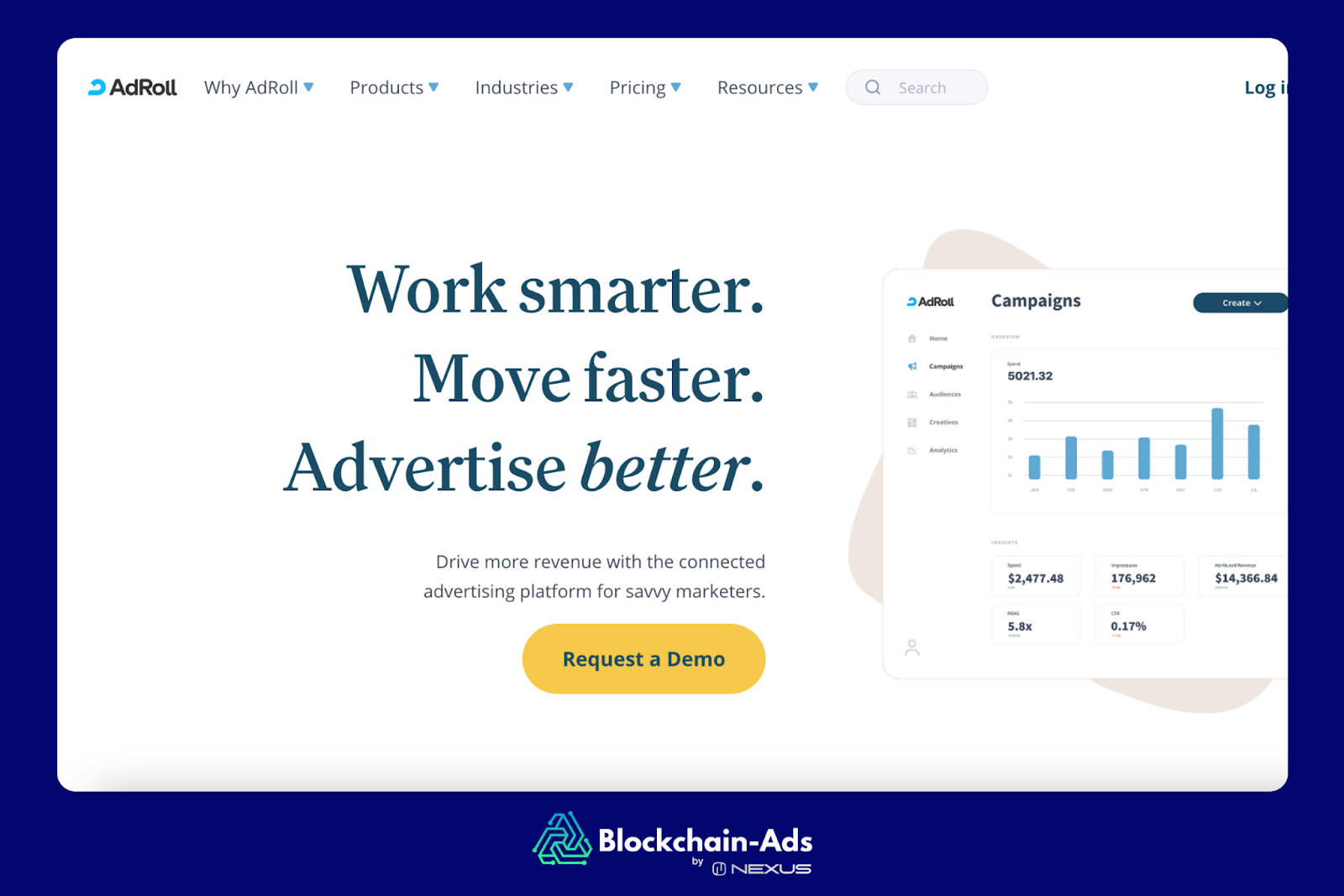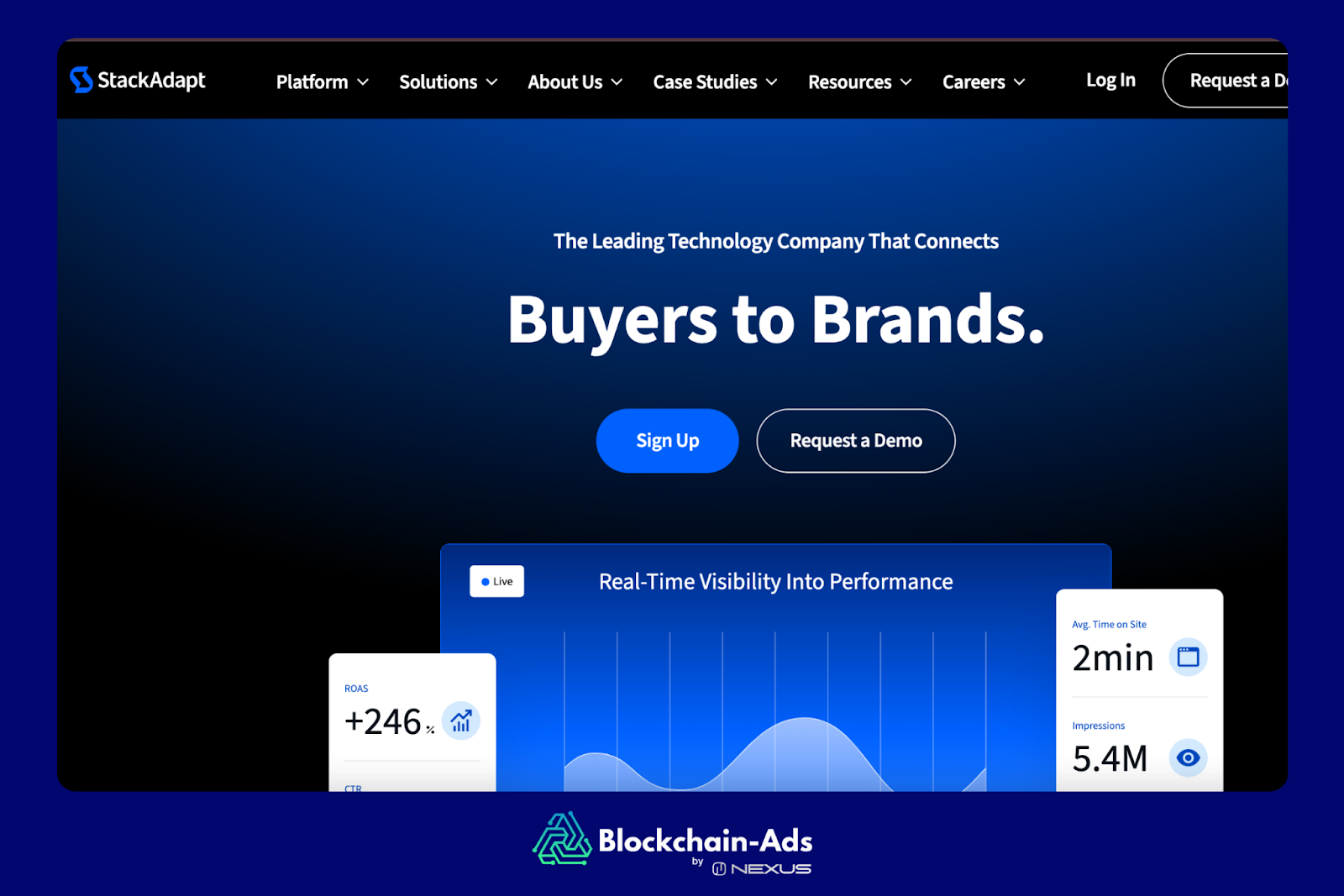Retargeting Advertising: How It Works, Types, Strategy & Performance
Heading
- Cointelegraph Formula offers various ad formats to 8 million monthly readers across 190+ countries, leveraging its trusted name in crypto.
Retargeting advertising is used by brands to re-engage customers who have previously interacted with them but didn't convert. It uses tracking technologies like pixels and cookies to reconnect with users who abandoned carts or browsed products but didn’t convert. This strategy can boost conversion rates by up to 150% and increase the chances of purchase by 43% compared to first-time visitors.
There are different types of retargeting Ads including pixel-based, list-based, dynamic, search, contextual & behavioural and cookie-less retargeting. Each type offers distinct advantages depending on your audience data and privacy needs.
For best results, retargeted ads should be tailored to match buyers intent from when they learn about the brand to when they decide to buy. However, it relies on clear audience segmentation, well-timed ads, and tracking key metrics, to pull off successfully. Blockchain-Ads solves this challenge by providing privacy-focused tracking, advanced behavioural and interest based audience targeting, and real-time AI optimization.
In this article, you'll learn how retargeting works, the main types, how to set it up, and how to monitor performance.
What Is Retargeting Advertising?
Retargeting advertising is a form of digital marketing that uses personalized ads to approach familiar users. The goal of retargeting is to reignite consumer interest in a brand and prompt a product purchase or subscription. What makes retargeting different from traditional advertising is its audience and precision.
Traditional ads target a broad audience with little to no knowledge of a product, while retargeting focuses on specific customers who know about the brand. For example, some users interact with ads by visiting a website, using the app, or engaging with content, but then do nothing else.
Since they've demonstrated interest or an intent to purchase, retargeting is an effective strategy for increasing conversions.
Retargeting will not only help businesses recover lost opportunities but also maximize the ROI on advertisements. According to reports, the click-through rates (CTR) on retargeting ads are ten times higher than traditional ads.
How Does Ad Retargeting Work?
Retargeting ads work through a combination of pixels, browser cookies, and tracking mechanisms that help advertisers reconnect with previous visitors. Businesses set up a pixel on their website which attaches a tracking cookie on the browser of every visitor. This tracking cookie logs page views, time spent or items added to the cart.
Users who exit the site or app without making a purchase will have their interests stored in the cookie.
The business can then create tailored ads and push them to users through server-side tracking mechanisms.
Retargeting vs Remarketing: What’s the Difference?
Retargeting and remarketing are digital marketing strategies designed to re-engage users who have interacted with a provider. The approach is similar, but the messaging and medium are different.
Remarketing lets advertisers connect with users already invested in a product. They may have converted already through a subscription, app download, sign-up, or purchase but need to be reactivated.
Retargeting focuses on those who interacted with the product but didn't sign up, subscribe, download the app, or make a purchase.
The table below shows a clear comparison between both types of marketing and their use cases:
What Are the Different Types of Retargeting Ads?
Different types of retargeting ads help you re-engage audiences who interacted with your product in the past. These are the major types available today:
- Pixel-Based Retargeting
- List-Based Retargeting
- Dynamic Retargeting
- Search Retargeting
- Cookie-less Retargeting
- Contextual & Behavioral Retargeting
Pixel-Based Retargeting
This is the most common type, and it involves placing a small piece of code (a pixel) on a website. When a lead visits the platform, the pixel generates a cookie that tracks user behavior.
Blockchain-Ads Pixel, for example, allows advertisers to track user interactions like clicks, page views, unfulfilled carts, and wallet connections.
List-Based Retargeting
This retargeting method is ideal for targeting previous customers through their email addresses and CRM contacts. These users are re-engaged through ad platforms that support custom audiences, such as Blockchain-Ads, Google, Meta, and LinkedIn. When advertisers upload the list, the ad platform matches it with known profiles and delivers personalized ads.
Dynamic Retargeting
Dynamic retargeting involves publishing ads that feature a specific product or content with which the user previously interacted. It’s mostly used for e-commerce on platforms like Facebook Dynamic Ads and the Google Display Network. The algorithm automatically distributes ads with the same or similar content across partner websites.
Search Retargeting
With search retargeting, advertisers can reach potential customers based on their search engine queries. Ad platforms like Google or Microsoft will identify the relevant audience through keyword activity and push the ads on third-party websites. It's especially efficient for TOFU audiences that have shown interest in a product or service.
Cookie-less Retargeting
Cookie-less retargeting uses first-party data, unique identifiers, or signals to re-engage a target audience. It involves using device fingerprints, hashed emails, or cohort-based targeting, such as the Google Topics API solution.
Contextual & Behavioral Retargeting
Unlike other types of retargeting, behavioral and contextual retargeting focuses on the user's patterns. They're not being targeted directly; instead, their browsing behaviors are tracked to identify interests. Retargeting ads that employ this retargeting method comply better with privacy regulations.
Retargeting by Funnel Stage: How to Match Ads to Buyer Intent

There are strategic ways to retarget users for it to be effective. As customers move through the funnel stages, their intents and motivations change, and so should the ad experience. These are the primary stages that determine how a retargeting ad campaign should be crafted:
- Awareness stage
- Consideration stage
- Decision stage
Awareness Stage Retargeting
At the TOFU stage, users have only had a brief interaction with the product and will want to learn more about it. Retargeting at this level should prioritize value by providing helpful information that will spark curiosity. The ads should be visually appealing and story-driven, using formats like YouTube pre-rolls, display, or native.
Consideration Stage Retargeting
In the MOFU stage, potential customers are still evaluating the product and comparing it with similar ones. The goal of retargeting at this level should be dynamic and should remind users of viewed or carted items. Ads that feature short reviews, testimonials, or explainer videos work best.
Decision Stage Retargeting
The bottom of the funnel (BOFU) is where you'll find users who are ready to purchase. Retargeting ads for the decision stage should be incentivized to create urgency. Advertisers can implement this by including discounts and purchase time limits on products. Email and CRM-based ads are effective tools that are most impactful for this stage.
How to Create a Retargeting Campaign
Creating a successful retargeting ad campaign involves careful planning, segmentation, and tracking. A well-structured ad will help you reach the right audiences with the most persuasive messages at the right time. These are the steps to take when creating a retargeting ad campaign:
- Define Your Audience Segments
- Choose a Retargeting Platform
- Craft Your Ad Creatives
- Set Frequency and Duration
- Track, Optimize, and Scale
1. Define Your Audience Segments
Identify and segment users based on behaviors like site visits, content views, downloads, or abandoned carts. Use tools like Blockchain-Ads Pixel, Google Analytics 4, and Meta Pixel to collect accurate first-party data for precise targeting.
2. Choose a Retargeting Platform
Select platforms aligned with your campaign goals and target audience habits. Leading options include Blockchain-Ads for privacy-first, blockchain-verified tracking, Meta Ads, and Google Ads.
3. Craft Your Ad Creatives
Design ad messages that resonate with users at their current funnel stage. Use product images, testimonials, videos, and strong calls to action to motivate conversions.
4. Set Frequency and Duration
Control how often and how long your ads run to minimize audience fatigue and keep your campaign fresh and effective.
5. Track, Optimize, and Scale
Monitor key metrics using Blockchain-Ads Analytics, AppsFlyer, Adjust, Google Analytics 4, or Meta Ads Manager. Identify top-performing ads to scale up while reducing spend on underperformers.
Popular Retargeting Advertising Platforms
These are the most popular and efficient retargeting ad platforms to use in:
- Blockchain-Ads
- Google Ads
- Meta Ads (Facebook & Instagram)
- AdRoll
- StackAdapt
- The Trade Desk
Blockchain-Ads

Blockchain-Ads offers a privacy-enabled retargeting platform designed for precise audience engagement. It features advanced targeting including wallet-based, interest-based, and behavioral segmentation, supported by regional compliance tools and multiple retargeting methods such as pixel, server-to-server (S2S), and contextual retargeting. Blockchain-Ads has in-built analytics but also integrates seamlessly with analytics tools for comprehensive insights.
Brands like Fairspin have used Blockchain-Ads’ platform for a phased retargeting campaign to secure 70% recurring customers from first-time depositors, and attained a 4x return on ad spend (ROAS).
Google Ads

Google Ads offers one of the most robust ecosystems for retargeting due to its product catalog. These include Google Search, Gmail, and YouTube. It uses pixel-based and list-based components to reconnect users to products and brands, with features like:
- Custom segmentation via Google Analytics 4
- Dynamic remarketing
- YouTube and Gmail ads integration
Meta Ads (Facebook & Instagram)

With the Meta Pixel and offline event sets, advertisers can re-engage users who already interacted with products. Meta’s ad network provides high-performance retargeting across Instagram, Facebook and the Meta Audience Network. The following features are available:
- Event-based optimization for engagement and conversion
- Dynamic product ads
- Custom Audiences, based on page visits or CRM uploads
AdRoll

As an ecommerce-focused retargeting automation platform, AdRoll supports both web and email retargeting. It uses AI to personalize ads based on browsing data and consumer purchase behavior. Some of the platform's features include:
- Real-time performance analytics
- Cross-platform and cross-device tracking
- Built-in email retargeting tools
StackAdapt

This ad platform is best known for its advanced targeting capabilities, which include GEO, contextual, and behavioral retargeting. It works best for B2B and B2C advertisers who expect retargeting precision across their display and native ads. Features available on StackAdapt include:
- Fraud prevention and pre-built audiences
- Customizable attribution models
- Cross-channel retargeting with cookies.
The Trade Desk

With the TradeDesk platform, advertisers can enjoy a holistic and privacy-centric retargeting campaign. It excels most in omnichannel retargeting across display, native, audio, and digital out-of-home mediums. The platform's features are:
- Unified ID 2.0 (UID2) identity resolution
- Lookback window and frequency caps
- Granular controls
How to Measure Retargeting Advertising Performance
To optimize a retargeting ad campaign, advertisers must evaluate the performance based on a combination of KPIs. Measuring these metrics will help improve the overall returns and make the campaign more successful. The following are the key metrics that can be tracked for better results:
- Conversion Rate (CVR) indicates how many users took action (signed up or made a purchase) after clicking the ad.
- Return on Ad Spend (ROAS) measures the revenue generated for every unit amount spent on the retargeting ad campaign.
- Click-through Rate (CTR) tells advertisers how many users clicked on an ad compared to the number who viewed it.
- Cost Per Acquisition (CPA) measures the ad spend per converted user.
- View-through Conversions (VTC) track users who viewed and didn’t click the ad but later converted through another channel.
Qualify and get acess to Blockchain-Ads
Lorem ipsum dolor sit amet, consectetur
Quick Definition

Mevcut ortaklarımızdan bazılarıyla konuşun
Tüm başarı öykülerini görüntüleyin

Reach 12M+
Engaged Web3 users across 10,000+ websites and 37 blockchains.






.png)